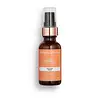What's inside
What's inside
 Key Ingredients
Key Ingredients

 Benefits
Benefits

 Concerns
Concerns

 Ingredients Side-by-side
Ingredients Side-by-side

Water
Skin ConditioningPropylene Glycol
HumectantGlycerin
HumectantVitis Vinifera Oil
PerfumingDimethicone
EmollientAscorbic Acid
AntioxidantXanthan Gum
EmulsifyingPolyacrylamide
C13-14 Isoparaffin
EmollientSodium Benzoate
MaskingPotassium Sorbate
PreservativeLaureth-7
EmulsifyingCitrus Aurantium Dulcis Peel Oil
MaskingLimonene
PerfumingSodium Hydroxide
BufferingCitral
PerfumingLinalool
PerfumingCI 77891
Cosmetic ColorantWater
Skin ConditioningButylene Glycol
HumectantGlycerin
Humectant1,2-Hexanediol
Skin ConditioningSodium Hyaluronate
HumectantPanthenol
Skin Conditioning3-O-Ethyl Ascorbic Acid
Skin ConditioningSodium PCA
HumectantPolysorbate 20
EmulsifyingGlycogen
HumectantAllantoin
Skin ConditioningEthylhexylglycerin
Skin ConditioningDisodium EDTA
Linoleic Acid
CleansingCentella Asiatica Extract
CleansingOleic Acid
EmollientPalmitic Acid
EmollientStearic Acid
CleansingLinolenic Acid
CleansingTocopherol
AntioxidantPEG-60 Hydrogenated Castor Oil
EmulsifyingParfum
MaskingCitronellol
PerfumingLimonene
PerfumingGeraniol
PerfumingLinalool
PerfumingButylphenyl Methylpropional
PerfumingWater, Butylene Glycol, Glycerin, 1,2-Hexanediol, Sodium Hyaluronate, Panthenol, 3-O-Ethyl Ascorbic Acid, Sodium PCA, Polysorbate 20, Glycogen, Allantoin, Ethylhexylglycerin, Disodium EDTA, Linoleic Acid, Centella Asiatica Extract, Oleic Acid, Palmitic Acid, Stearic Acid, Linolenic Acid, Tocopherol, PEG-60 Hydrogenated Castor Oil, Parfum, Citronellol, Limonene, Geraniol, Linalool, Butylphenyl Methylpropional
Ingredients Explained
These ingredients are found in both products.
Ingredients higher up in an ingredient list are typically present in a larger amount.
Glycerin is already naturally found in your skin. It helps moisturize and protect your skin.
A study from 2016 found glycerin to be more effective as a humectant than AHAs and hyaluronic acid.
As a humectant, it helps the skin stay hydrated by pulling moisture to your skin. The low molecular weight of glycerin allows it to pull moisture into the deeper layers of your skin.
Hydrated skin improves your skin barrier; Your skin barrier helps protect against irritants and bacteria.
Glycerin has also been found to have antimicrobial and antiviral properties. Due to these properties, glycerin is often used in wound and burn treatments.
In cosmetics, glycerin is usually derived from plants such as soybean or palm. However, it can also be sourced from animals, such as tallow or animal fat.
This ingredient is organic, colorless, odorless, and non-toxic.
Glycerin is the name for this ingredient in American English. British English uses Glycerol/Glycerine.
Learn more about GlycerinLimonene is a fragrance that adds scent and taste to a formulation.
It's found in the peel oil of citrus fruits and other plants such as lavender and eucalyptus. The scent of limonene is generally described as "sweet citrus".
Limonene acts as an antioxidant, meaning it helps neutralize free radicals.
When exposed to air, oxidized limonene may sensitize the skin. Because of this, limonene is often avoided by people with sensitive skin.
The term 'fragrance' is not regulated in many countries. In many cases, it is up to the brand to define this term. For instance, many brands choose to label themselves as "fragrance-free" because they are not using synthetic fragrances. However, their products may still contain ingredients such as essential oils that are considered a fragrance.
Learn more about LimoneneLinalool is a fragrance and helps add scent to products. It's derived from common plants such as cinnamon, mint, citrus, and lavender.
Like Limonene, this ingredient oxidizes when exposed to air. Oxidized linalool can cause allergies and skin sensitivity.
This ingredient has a scent that is floral, spicy tropical, and citrus-like.
Learn more about LinaloolWater. It's the most common cosmetic ingredient of all. You'll usually see it at the top of ingredient lists, meaning that it makes up the largest part of the product.
So why is it so popular? Water most often acts as a solvent - this means that it helps dissolve other ingredients into the formulation.
You'll also recognize water as that liquid we all need to stay alive. If you see this, drink a glass of water. Stay hydrated!
Learn more about Water